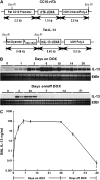Persistent effects induced by IL-13 in the lung
- PMID: 16645178
- PMCID: PMC2643287
- DOI: 10.1165/rcmb.2005-0474OC
Persistent effects induced by IL-13 in the lung
Abstract
IL-13 overexpression in the lung induces inflammatory and remodeling responses that are prominent features of asthma. Whereas most studies have concentrated on the development of IL-13-induced disease, far fewer studies have focused on the reversibility of IL-13-induced pathologies. This is particularly important because current asthma therapy appears to be poor at reversing lung remodeling. In this manuscript, we used an externally regulatable transgenic system that targets expression of IL-13 to the lung with the aim of characterizing the reversibility process. After 4 wk of doxycycline (dox) exposure, IL-13 expression resulted in mixed inflammatory cell infiltration, mucus cell metaplasia, lung fibrosis, and airspace enlargement (emphysema). After withdrawal of dox, IL-13 protein levels were profoundly reduced by 7 d and below baseline by 14 d. During this time frame, the level of lung eosinophils returned to near normal, whereas macrophages, lymphocytes, and neutrophils remained markedly elevated. IL-13-induced mucus cell metaplasia significantly decreased (91%) 3 wk after withdrawal of dox, showing strong correlation with reduced eosinophil levels. In contrast, IL-13-induced lung fibrosis did not significantly decline 4 wk after dox withdrawal. Importantly, IL-13-induced emphysema persisted, but modestly declined 4 wk after dox. Examination of transcript expression profiles identified a subset of genes that remained increased weeks after transgene expression was no longer detected. Notably, numerous IL-13-induced cytokines and enzymes were reversible (IL-6 and cathepsins), whereas others were sustained (CCL6 and chitinases) after IL-13 withdrawal, respectively. Thus, several hallmark features of IL-13-induced lung pathology persist and are dissociated from eosinophilia after IL-13 overexpression ceases.
Figures







Similar articles
-
Eosinophils and CCR3 regulate interleukin-13 transgene-induced pulmonary remodeling.Am J Pathol. 2006 Dec;169(6):2117-26. doi: 10.2353/ajpath.2006.060617. Am J Pathol. 2006. PMID: 17148674 Free PMC article.
-
IL-13 induces eosinophil recruitment into the lung by an IL-5- and eotaxin-dependent mechanism.J Allergy Clin Immunol. 2001 Oct;108(4):594-601. doi: 10.1067/mai.2001.118600. J Allergy Clin Immunol. 2001. PMID: 11590387
-
Inducible targeting of IL-13 to the adult lung causes matrix metalloproteinase- and cathepsin-dependent emphysema.J Clin Invest. 2000 Nov;106(9):1081-93. doi: 10.1172/JCI10458. J Clin Invest. 2000. PMID: 11067861 Free PMC article.
-
State of the art. Mechanistic heterogeneity in chronic obstructive pulmonary disease: insights from transgenic mice.Proc Am Thorac Soc. 2006 Aug;3(6):494-8. doi: 10.1513/pats.200603-068MS. Proc Am Thorac Soc. 2006. PMID: 16921126 Review.
-
Linking surfactant protein SP-D and IL-13: implications in asthma and allergy.Mol Immunol. 2013 May;54(1):98-107. doi: 10.1016/j.molimm.2012.10.039. Epub 2012 Dec 7. Mol Immunol. 2013. PMID: 23220073 Review.
Cited by
-
Regulatory effects of IL-15 on allergen-induced airway obstruction.J Allergy Clin Immunol. 2018 Mar;141(3):906-917.e6. doi: 10.1016/j.jaci.2017.05.025. Epub 2017 Jun 9. J Allergy Clin Immunol. 2018. PMID: 28606589 Free PMC article.
-
Interleukin-13-induced MUC5AC is regulated by 15-lipoxygenase 1 pathway in human bronchial epithelial cells.Am J Respir Crit Care Med. 2009 May 1;179(9):782-90. doi: 10.1164/rccm.200811-1744OC. Epub 2009 Feb 12. Am J Respir Crit Care Med. 2009. PMID: 19218191 Free PMC article.
-
Interleukin-13 as a target to alleviate severe coronavirus disease 2019 and restore lung homeostasis.J Clin Transl Res. 2021 Feb 25;7(1):116-120. eCollection 2021 Feb 25. J Clin Transl Res. 2021. PMID: 34027204 Free PMC article.
-
Interleukin-13 induces collagen type-1 expression through matrix metalloproteinase-2 and transforming growth factor-β1 in airway fibroblasts in asthma.Eur Respir J. 2014 Feb;43(2):464-73. doi: 10.1183/09031936.00068712. Epub 2013 May 16. Eur Respir J. 2014. PMID: 23682108 Free PMC article.
-
IL-13 induces esophageal remodeling and gene expression by an eosinophil-independent, IL-13R alpha 2-inhibited pathway.J Immunol. 2010 Jul 1;185(1):660-9. doi: 10.4049/jimmunol.1000471. Epub 2010 Jun 11. J Immunol. 2010. PMID: 20543112 Free PMC article.
References
-
- Bousquet J, Chanez P, Lacoste JY, White R, Vic P, Godard P, Michel FB. Asthma: a disease remodeling the airways. Allergy 1992;47:3–11. - PubMed
-
- Wills-Karp M, Luyimbazi J, Xu X, Schofield B, Neben TY, Karp CL, Donaldson DD. Interleukin-13: central mediator of allergic asthma. Science 1998;282:2258–2261. - PubMed
-
- Kuperman DA, Huang X, Koth LL, Chang GH, Dolganov GM, Zhu Z, Elias JA, Sheppard D, Erle DJ. Direct effects of interleukin-13 on epithelial cells cause airway hyperreactivity and mucus overproduction in asthma. Nat Med 2002;8:885–889. - PubMed
Publication types
MeSH terms
Substances
Grants and funding
LinkOut - more resources
Full Text Sources
Other Literature Sources
Medical
Molecular Biology Databases
Miscellaneous

